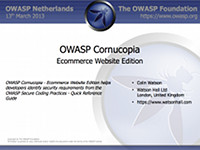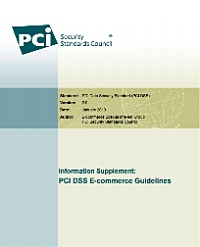OWASP Cornucopia

OWASP Cornucopia is a mechanism in the form of a card game to assist software development teams identify security requirements in Agile, conventional and formal development processes. It is language, platform and technology-agnostic.
Introduction
The idea behind Cornucopia is to help development teams, especially those using Agile methodologies, to identify application security requirements and develop security-based user stories. Although the idea had been waiting for enough time to progress it, the final motivation came when SAFECode published its Practical Security Stories and Security Tasks for Agile Development Environments in July 2012.
The Microsoft SDL team had already published its super Elevation of Privilege: The Threat Modeling Game (EoP) but that did not seem to address the most appropriate kind of issues that web application development teams mostly have to address. EoP is a great concept and game strategy, and was published under a Creative Commons Attribution License. Cornucopia Ecommerce Website Edition is based the concepts and game ideas in EoP, but those have been modified to be more relevant to the types of issues ecommerce website developers encounter. It attempts to introduce threat-modelling ideas into development teams that use Agile methodologies, or are more focused on web application weaknesses than other types of software vulnerabilities or are not familiar with STRIDE and DREAD.
To start using Cornucopia:
- Either: Obtain or buy a pre-printed deck of cards
- Or: Download the document
- Print the cards onto plain paper or pre-scored card
- Cut/separate the individual cards
- Identify an application, module or component to assess
- Invite business owners, architects, developers, testers along for a card game
- Get those infosec folk to provide chocolate, pizza, beer, flowers or all four as prizes
- Select a portion of the deck to start with
- Play the game to discuss & document security requirements (and to win rounds)
- Remember, points make prizes!
The Card Decks
Ecommerce Website Edition
Instead of EoP’s STRIDE suits, Cornucopia suits were selected based on the structure of the OWASP Secure Coding Practices - Quick Reference Guide (SCP), but with additional consideration of sections in the OWASP Application Security Verification Standard, the OWASP Web Security Testing Guide and David Rook’s Principles of Secure Development. These provided five suits, and a sixth called “Cornucopia” was created for everything else:
- Data validation and encoding
- Authentication
- Session management
- Authorization
- Cryptography
- Cornucopia
Each suit contains 13 cards (Ace, 2-10, Jack, Queen and King) but, unlike EoP, there are also two Joker cards. The content was mainly drawn from the SCP. Full Wiki Deck.
Other Decks
Future editions such as for mobile app development will use different sources of information and suits.
Mappings
The other driver for Cornucopia is to link the attacks with requirements and verification techniques. An initial aim had been to reference CWE weakness IDs, but these proved too numerous, and instead it was decided to map each card to CAPEC software attack pattern IDs which themselves are mapped to CWEs, so the desired result is achieved.
Each card is also mapped to the 36 primary security stories in the SAFECode document, as well as to the OWASP SCP v2, ASVS v3.0.1 and AppSensor (application attack detection and response) to help teams create their own security-related stories for use in Agile processes.
Licensing
OWASP Cornucopia is free to use. It is licensed under the Creative Commons Attribution-ShareAlike 3.0 license, so you can copy, distribute and transmit the work, and you can adapt it, and use it commercially, but all provided that you attribute the work and if you alter, transform, or build upon this work, you may distribute the resulting work only under the same or similar licence to this one.
© OWASP Foundation
Other Security Gamification
If you are interested in using gaming for security, also see Elevation of Privilege: The Threat Modeling Game, Security Cards from the University of Washington, the commercial card game Control-Alt-Hack (presentation), OWASP Snakes and Ladders, and web application security training tools incorporating gamification such as OWASP Hackademic Challenges Project, OWASP Security Shepherd and ITSEC Games.
Additionally, Adam Shostack maintains a list of tabletop security games and related resources at security games.
Get the Cards
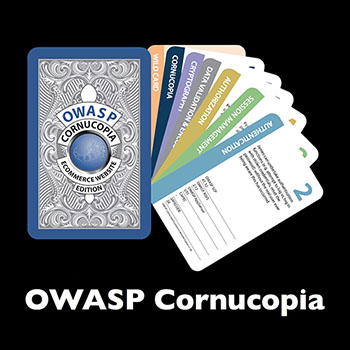
The primary source document is a Word document. However, pre-printed card decks may be more useful, or there are links to the source design files for the cards themselves.
Printed
OWASP does not endorse or recommend commercial products or services, however, Agile Stationary offer large print (v1.20) decks at a discount to OWASP Members. They also offer a croupier to help you distribute cards to team members. Also, dotNET lab sell a printed deck which complements their online reference.
Source files
Cornucopia - Ecommerce Website Edition:
v1.2x (current version)
The current version of Cornucopia Ecommerce Website Edition cards (v1.21 with updated mapping to ASVS v3.0.1 and CAPEC v2.8, and has some minor text changes on the cards) can be printed using the following methods:
- Download the free Adobe Illustrator files and get them professionally printed
- Download and self-print the free document word-processing or PDF
- Print the document onto business card blank cards; or
- Print the document onto normal card and cut the cards out individually using the guide; or
- Generate your own cards from the free source XML data file
There are also other ways to obtain particular versions.
How to Play
It is possible to play Cornucopia in many different ways. Here is one way, and explained in a YouTube video.
Primary method
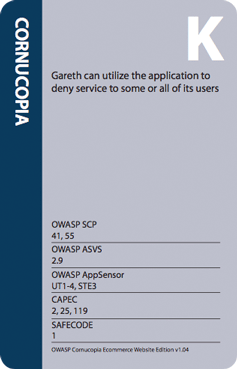
A - Preparations
A1. Obtain a deck, or print your own Cornucopia deck and separate/cut out the cards
A2. Identify an application or application process to review; this might be a concept, design or an actual implementation
A3. Create a data flow diagram
A4. Identify and invite a group of 3-6 architects, developers, testers and other business stakeholders together and sit around a table (try to include someone fairly familiar with application security)
A5. Have some prizes to hand (gold stars, chocolate, pizza, beer or flowers depending upon your office culture)
B - Play
One suit - Cornucopia - acts as trumps. Aces are high (i.e. they beat Kings). It helps if there is someone dedicated to documenting the results who is not playing.
B1. Remove the Jokers and a few low-score (2, 3, 4) cards from Cornucopia suit to ensure each player will have the same number of cards
B2. Shuffle the pack and deal all the cards
B3. To begin, choose a player randomly who will play the first card - they can play any card from their hand except from the trump suit - Cornucopia
B4. To play a card, each player must read it out aloud, and explain how (or not) the threat could apply (the player gets a point for attacks that work, and the group thinks it is an actionable bug) - don’t try to think of mitigations at this stage, and don’t exclude a threat just because it is believed it is already mitigated - someone record the card on the score sheet
B5. Play clockwise, each person must play a card in the same way; if you have any card of the matching lead suit you must play one of those, otherwise they can play a card from any other suit. Only a higher card of the same suit, or the trump suit Cornucopia, wins the hand.
B6. The person who wins the round, leads the next round (i.e. they play first), and thus defines the next lead suit
B7. Repeat until all the cards are played
C - Scoring
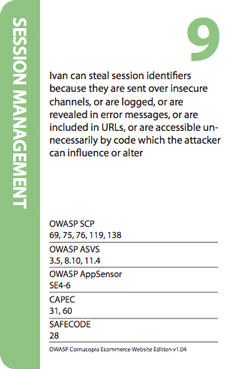
The objective is to identify applicable threats, and win hands (rounds):
C1. Score +1 for each card you can identify as a valid threat to the application under consideration
C2. Score +1 if you win a round
C3. Once all cards have been played, whoever has the most points wins
D - Closure
D1. Review all the applicable threats and the matching security requirements
D2. Create user stories, specifications and test cases as required for your development methodology
See Márk Vinkovits leading a threat modelling talk and group session playing Cornucopia in the OWASP track @hacktivityconf 1510.
Alternative game rules
- If you are new to the game, remove the two Joker cards to begin with. Add the Joker cards back in once people become more familiar with the process. Apart from the “trumps card game” rules described above which are very similar to the EoP, the deck can also be played as the “twenty-one card game” (also known as “pontoon” or “blackjack”) which normally reduces the number of cards played in each round.
- Practice on an imaginary application, or even a future planned application, rather than trying to find fault with existing applications until the participants are happy with the usefulness of the game.
- Consider just playing with one suit to make a shorter session – but try to cover all the suits for every project. Or even better just play one hand with some pre-selected cards, and score only on the ability to identify security requirements. Perhaps have one game of each suit each day for a week or so, if the participants cannot spare long enough for a full deck.
- Some teams have preferred to play a full hand of cards, and then discuss what is on the cards after each round (instead of after each person plays a card).
- Another suggestion is that if a player fails to identify the card is relevant, allow other players to suggest ideas, and potentially let them gain the point for the card. Consider allowing extra points for especially good contributions.
- You can even play by yourself. Just use the cards to act as thought-provokers. Involving more people will be beneficial though.
- In Microsoft’s EoP guidance, they recommend cheating as a good game strategy.
Frequently Asked Questions
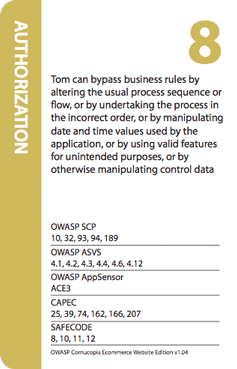
Can I copy or edit the game?
Yes of course. All OWASP materials are free to do with as you like provided you comply with the Creative Commons Attribution-ShareAlike 3.0 license. Perhaps if you create a new version, you might donate it to the OWASP Cornucopia Project?
How can I get involved?
Please send ideas or offers of help to the project’s mailing list.
How were the attackers’ names chosen?
EoP begins every description with words like “An attacker can…”. These have to be phrased as an attack but I was not keen on the anonymous terminology, wanting something more engaging, and therefore used personal names. These can be thought of as external or internal people or aliases for computer systems. But instead of just random names, I thought how they might reflect the OWASP community aspect. Therefore, apart from “Alice and Bob”, I use the given (first) names of current and recent OWASP employees and Board members (assigned in no order), and then randomly selected the remaining 50 or so names from the current list of paying individual OWASP members. No name was used more than once, and where people had provided two personal names, I dropped one part to try to ensure no-one can be easily identified. Names were not deliberately allocated to any particular attack, defence or requirement. The cultural and gender mix simply reflects theses sources of names, and is not meant to be world-representative.
Why aren’t there any images on the card faces?
There is quite a lot of text on the cards, and the cross-referencing takes up space too. But it would be great to have additional design elements included. Any volunteers?
Are the attacks ranked by the number on the card?
Only approximately. The risk will be application and organisation dependent, due to varying security and compliance requirements, so your own severity rating may place the cards in some other order than the numbers on the cards.
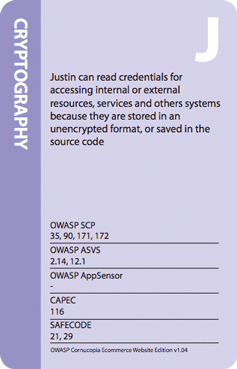
How long does it take to play a round of cards using the full deck?
This depends upon the amount of discussion and how familiar the players are with application security concepts. But perhaps allow 1.5 to 2.0 hours for 4-6 people.
What sort of people should play the game?
Always try to have a mix of roles who can contribute alternative perspectives. But include someone who has a reasonable knowledge of application vulnerability terminology. Otherwise try to include a mix of architects, developers, testers and a relevant project manager or business owner.
Who should take notes and record scores?
It is better if that someone else, not playing the game, takes notes about the requirements identified and issues discussed. This could be used as training for a more junior developer, or performed by the project manager. Some organisations have made a recording to review afterwards when the requirements are written up more formally.
Should we always use the full deck of cards?
No. A smaller deck is quicker to play. Start your first game with only enough cards for two or three rounds. Always consider removing cards that are not appropriate at all of the target application or function being reviewed. For the first few times people play the game it is also usually better to remove the Aces and the two Jokers. It is also usual to play the game without any trumps suit until people are more familiar with the idea.
What should players do when they have an Ace card that says “invented a new X attack”?
The player can make up any attack they think is valid, but must match the suit of the card e.g. data validation and encoding). With players new to the game, it can be better to remove these to begin with.
I don’t understand what the attack means on each card - is there more detailed information?
Yes, the Wiki Deck at was created to help players understand the attacks. See Wiki Deck.
My company wants to print its own version of OWASP Cornucopia - what license do we need to refer to?
What is required/reasonable might depend upon how you propose to use the source Cornucopia material. See fuller answer immediately below. Some examples of re-using or reproducing Cornucopia are:
- Print some decks and give them away to customers
- Reproduce the game exactly but with a corporate-branded package
- Use the idea and/or source files to produce a similar game but with different attacks/mappings
- Distribute modified design files
If option 1 above, you can order these in bulk from OWASP and attach your own details below the “compliments of” section on the boxes. There are three aspects to consider for options 2, 3 or 4, or combinations of those - see below. The existing printed decks (and their boxes and leaflets include such text).
A - Cornucopia License
The precise wording will depend how the material is being used or reproduced. Under Creative Commons Attribution-ShareAlike 3.0 license it is necessary to attribute all previous contributions (in this case, Microsoft, Boeing, Mitre, etc). The easiest place to put the wording is on the leaflet (folded inside, or separate booklet). The current required long-form wording is:
OWASP Cornucopia is licensed under the Creative Commons Attribution-ShareAlike 3.0 license http://creativecommons.org/licenses/by-sa/3.0/
The files used to create these materials were created from the OWASP project and are also open source, and are licensed under the same conditions.
OWASP Cornucopia can be downloaded for free from the OWASP website and printed yourself. The OWASP Cornucopia project source in vendor neutral and unbranded.
OWASP does not endorse or recommend commercial products or services.
© 2012-2018 OWASP Foundation
This document is licensed under the Creative Commons Attribution-ShareAlike 3.0 license.
Acknowledgments:
Microsoft SDL Team for the Elevation of Privilege Threat Modelling Game, published under a Creative Commons Attribution license, as the inspiration for Cornucopia and from which many ideas, especially the game theory, were copied.
Keith Turpin and contributors to the “OWASP Secure Coding Practices - Quick Reference Guide”, originally donated to OWASP by Boeing, which is used as the primary source of security requirements information to formulate the content of the cards.
Contributors, supporters, sponsors and volunteers to the OWASP ASVS, AppSensor and Web Framework Security Matrix projects, Mitre’s Common Attack Pattern Enumeration and Classification (CAPEC), and SAFECode’s “Practical Security Stories and Security Tasks for Agile Development Environments” which are all used in the cross-references provided.
Playgen for providing an illuminating afternoon seminar on task gamification, and tartanmaker.com for the online tool to help create the card back pattern.
Blackfoot UK Limited for creating and donating print-ready design files, Tom Brennan and the OWASP Foundation for instigating the creation of an OWASP-branded box and leaflet, and OWASP employees, especially Kate Hartmann, for managing the ordering, stocking and despatch of printed card decks.
Oana Cornea and other participants at the AppSec EU 2015 project summit for their help in creating the demonstration video.
Colin Watson as author and co-project leader with Darío De Filippis, along with other OWASP volunteers who have helped in many ways.
The box/container for the cards must have the wording:
Created by Colin Watson.
Contains: One pack of Cornucopia Ecommerce Website playing cards. OWASP Cornucopia is open source and can be downloaded free of charge from the OWASP website.
OWASP Cornucopia is free to use. It is licensed under the Creative Commons Attribution-ShareAlike 3.0 license, so you can copy, distribute and transmit the work, and you can adapt it, and use it commercially, but all provided that you attribute the work and if you alter, transform, or build upon this work, you may distribute the resulting work only under the same or similar license to this one.
The following short-form wording must also appear on any materials referencing the outputs (e.g. press releases, leaflets, reports, blog posts):
OWASP does not endorse or recommend commercial products or services.
OWASP Cornucopia is licensed under the Creative Commons Attribution-ShareAlike 3.0 license and is © 2012-2016 OWASP Foundation.
If any files are distributed electronically, the long-form wording should also be aded in a license.txt file within the distribution.
If the intention is to use the idea only (option 3 above), the long-form, box and short-form wording might be different, and probably simpler. And it might make more sense to start with the Microsoft-provided Elevation of Privilege files (and open source license).
B - Upcoming update to Cornucopia
Note that the current print design files are v1.04, and the current Word document is v1.10, but we are in the process of updating all of these to v1.20.
Whatever is used as a starting point, please state the source version, for example:
Based on OWASP Cornucopia Ecommerce Website Edition v1.04
C - OWASP brand usage
Additionally individuals, companies and other organisations must not breach OWASP’s brand usage guidelines.
In the case of Cornucopia, in 2014 Blackfoot Limited produced some printed decks of cards. Blackfoot’s name and logo did not appear anywhere on the OWASP-branded cards, and the OWASP logo did not appear on the Blackfoot-branded box and leaflet. In fact there is no OWASP logo on any part of the Blackfoot branded decks.
Acknowledgements
Volunteers
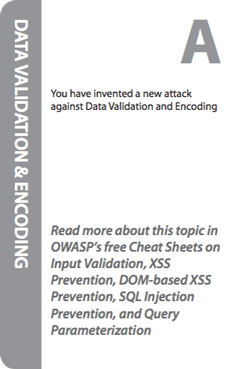
Cornucopia is developed, maintained, updated and promoted by a worldwide team of volunteers. The contributors to date have been:
- Artim Banyte
- Simon Bennetts
- Thomas Berson
- Tom Brennan
- Graham Bryant
- Fabio Cerullo
- Oana Cornea
- Johanna Curiel
- Todd Dahl
- Luis Enriquez
- Ken Ferris
- Darío De Filippis
- Spyros Gasteratos
- Sebastien Gioria
- Tobias Gondrom
- Timo Goosen
- Anthony Harrison
- Martin Haslinger
- John Herrlin
- Jerry Hoff
- Toby Irvine
- Marios Kourtesis
- Franck Lacosta
- Mathias Lemaire
- Antonis Manaras
- Jim Manico
- Mark Miller
- Cam Morris
- Grant Ongers
- Susana Romaniz
- Ravishankar Sahadevan
- Tao Sauvage
- Max Alejandro Gómez Sánchez Vergaray
- Wagner Voltz
- Stephen de Vries
- Colin Watson
Also:
- Attendees at OWASP London, OWASP Manchester and OWASP Netherlands chapter meetings, the London Gamification meetup, and the training at AppSec USA 2015 in San Francisco who made helpful suggestions and asked challenging questions
Others
- Microsoft SDL Team for the Elevation of Privilege Threat Modelling Game, published under a Creative Commons Attribution license, as the inspiration for Cornucopia and from which many ideas, especially the game theory, were copied.
- Keith Turpin and contributors to the “OWASP Secure Coding Practices - Quick Reference Guide”, originally donated to OWASP by Boeing, which is used as the primary source of security requirements information to formulate the content of the cards.
- Contributors, supporters, sponsors and volunteers to the OWASP ASVS, AppSensor and Web Framework Security Matrix projects, Mitre’s Common Attack Pattern Enumeration and Classification (CAPEC), and SAFECode’s “Practical Security Stories and Security Tasks for Agile Development Environments” which are all used in the cross-references provided.
- Playgen for providing an illuminating afternoon seminar on task gamification, and tartanmaker.com for the online tool to help create the card back pattern.
- Blackfoot UK Limited for creating and donating print-ready design files, Tom Brennan and the OWASP Foundation for instigating the creation of an OWASP-branded box and leaflet, and OWASP employees, especially Kate Hartmann, for managing the ordering, stocking and despatch of printed card decks.
- Agile Stationary for producing packs for sale contributing to wider awareness of the project.
- Oana Cornea and other participants at the AppSec EU 2015 project summit for their help in creating the demonstration video.
- Colin Watson as author, former co-project leader Darío De Filippis, and current co-project leader Grant Ongers along with other OWASP volunteers who have helped in many ways.
Road Map and Getting Involved
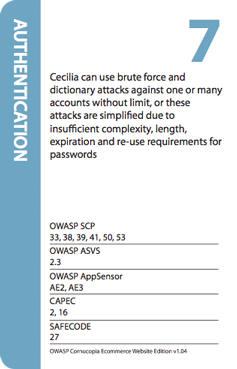
Involvement in the development and promotion of Cornucopia is actively encouraged! You do not have to be a security expert in order to contribute. Some of the ways you can help are listed below.
Localization
Are you fluent in another language? Can you help translate Cornucopia into that language? Niote tthis is a very large task due to the number of documents involved.
Use and Promote the Cornucopia Card Decks
Please help raise awareness of Cornucopia by printing cards:
- Use Cornucopia with specifiers, architects, designers, developers, testers and others, in part to train them, but also to solicit feedback on their usability, practicality and appropriateness for their work
- Create video about how to play the game
- Develop a mobile app to play the game
Feedback
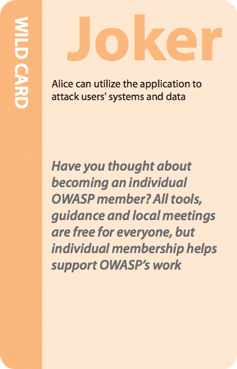
Please use the friendly project Google Group for feedback:
- What do like?
- What don’t you like?
- What cards don’t make sense?
- How could the guidance be improved?
- What other decks would you like to see?
Keep the Cards Updated
As the source referenced documents change, we have to update the decks. You may also find errors and omissions. In the first instance, please send a message to the project’s Google Group if you have identified errors & omissions, have some time to maintain the source documents, or can help in other ways.
Create a New Deck
The only version currently available is the Cornucopia Ecommerce Website Edition in English. We would like to create a new mobile app specific deck, probably using the wonderful OWASP Mobile Security Project as inspiration for the card source materials. Do you have an idea for your own application security requirements card deck? Perhaps for mobile apps or something else?

